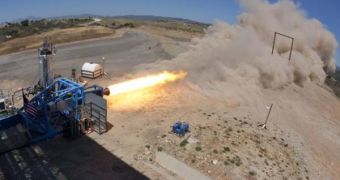Virgin Galactic is a space tourist firm that has been trying for quite some time now to make the dream of suborbital space flights possible for the wealthy. It plans on doing so by using a craft known as SpaceShipTwo, which is able to achieve impressive heights for a few minutes, before plunging back into the atmosphere. The experience is said to be amazing for those participating, but naturally hazards and technical issues exist in abundance. Recently, the engineering team behind the project managed a cornerstone achievement, when they successfully tested the rocket motor booster set to send the craft high into the air.
This is but the last in a long series of tests that Virgin Galactic has performed in the Californian deserts. Other crafts tested included WhiteKnightTwo, the carrier aircraft for the SpaceShip2. The plane, dubbed Eve, has recently performed its longest flight yet, and engineers discovered a small ding on its tail afterwards. Despite the fact that chances are slim the damage occurred because of the flight, engineers are looking into it nonetheless, in order to minimize any potential threats on their vessel.
“SpaceShipTwo, which will air launch from Eve, is largely constructed and awaiting the start of its own test flight program later this year,” said the founder of Virgin Galactic, British billionaire Sir Richard Branson. The spacecraft his company is designing will be able to carry six paying passengers into orbit, in addition to two crew members. It will be able to travel at more than 2,500 miles per hour (4,000 kilometers per hour), and reach heights of more than 65 miles (110 kilometers). It's estimated that the price of a ticket will be around $200,000.
SpaceShipTwo will take off under the wing of Eve, and will separate from its carrier aircraft at a very high altitude. This means that it will only have to ignite its own engines for a very short period of time. The carbon footprint of such a travel is estimated to be about a quarter of that of a return trip from London to New York, Space reports. “This means much less fuel is required – fuel which provides none of the toxins that are present in the solid rockets used by the space shuttle and satellite launches,” Branson stated.

 14 DAY TRIAL //
14 DAY TRIAL //